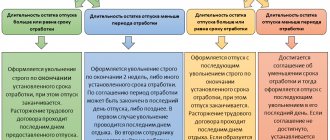During pregnancy and after childbirth, a woman has legal grounds to declare maternity leave if her work activity is officially registered in any organization. She is also entitled to cash payments without having to go to work until the child turns 3 years old.
Therefore, cases of termination of an employment agreement on the personal initiative of an employee on maternity leave are extremely rare. The reasons for this may be either the liquidation of the old enterprise or the transition to a new place of duty.
How to do it?
The dismissal of an employee on maternity leave follows the same pattern as for a currently employed person. According to Part 1 of Art. 80 of the Labor Code of the Russian Federation, at least 14 calendar days before the date of dismissal, the employee submits an application for termination of the employment contract.
Remember that the 14-day countdown does not start from the day the application is submitted, but from the next day. Under the same article, but part 2, they can be fired earlier if the employee and the employer agree among themselves.
Dismissal after maternity leave at your own request
The procedure for dismissing an employee at his request after leaving does not differ from that described above.
Procedure for dismissal after maternity leave
Also, 2 weeks before the planned date of dismissal, the employee submits a statement that he wishes to terminate the employment contract on his own initiative. After 2 weeks have passed after submitting the application to the employer, the employee can stop working even in the absence of a corresponding order (Part 5 of Article 80 of the Labor Code of Russia). At the same time, if during these 2 weeks the employee changed his mind about quitting and the employer did not invite another employee to this position by sending a written request/invitation, the application can be withdrawn and the employment relationship can be continued (Part 4 of Article 80 of the Labor Code).
If, after 2 weeks, the contractual relationship with the employee has not actually been terminated and the initiator of the dismissal no longer insists on this, the validity of the employment contract is considered continued (Part 6 of Article 80 of the Labor Code).
If the employer does not want to let the employee go
In practice, employers are often in no hurry to satisfy employees’ requests to resign at their own request. This reluctance may be due to both a shortage of personnel at the enterprise and the difficulty (and sometimes impossibility) of replacing a specialist - in such circumstances, the departure of a valuable employee negatively affects the entire economic activity of the company.
If the employer does not accept the application from the employee or does not endorse it and does not proceed with it, the only way out for the employee is to send the application by mail with a written list of the attachments. The date the letter is received by the employer will be the countdown period for the required 2 weeks for notice of dismissal. After 2 weeks, the employee may not go to work, and the employer is obliged to issue him a work book and make a full payment.
How to write a statement from a maternity leaver?
The application can be handwritten or printed, but must be signed by the person resigning. It is written using a standard form, which can be downloaded on the Internet or taken from the personnel department.
In the upper right corner it is indicated in whose name the application is being submitted: either this is the director of the organization or the executing person. You can also clarify this in the HR department, even by phone. If you resign of your own free will, then write this in the reason for dismissal; there is no need to describe in detail why you decided to terminate your employment relationship. Write the date on which you quit.
As a rule, employees on maternity leave are not asked to give notice of dismissal two weeks in advance, but are released earlier, so write the date you agreed on with your manager.
At the end of the application, be sure to indicate the date of submission and put a signature with a transcript. The application is ready.
You can submit your application in person or by mail. In any case, it is recommended to submit the application in two copies, in one of which the employer will mark the acceptance, and it is better to send it by registered mail with notification, in order to be sure that the letter has been received.
Submitting an application in person will speed up the process of receiving your documents, since you do not need to wait for the courier to deliver the letter to the address.
Who will fill the vacant position?
Expert opinion
Polyakov Pyotr Borisovich
Lawyer with 6 years of experience. Specialization: civil law. More than 3 years of experience in drafting contracts.
Since both employees were hired under fixed-term employment contracts for the period of absence of the main employee, who is on maternity leave, there is no priority in the question of who will now be the main employee.
This issue is not regulated by law. It would be more logical for the place of the main employee to be taken by a woman who was the first to be hired under a fixed-term contract to replace the absent one. However, she is on maternity leave and, most likely, as practice shows, she will follow him on maternity leave. Therefore, it is logical that the employer will resolve the issue at his own discretion.
For the purpose of effective economic activity and rational management of property, the employer independently, under his own responsibility, makes the necessary personnel decisions (selection, placement, dismissal of personnel) (clause 10 of the Resolution of the Plenum of the Armed Forces of the Russian Federation dated March 17, 2004 No. 2 “On the application by the courts of the Russian Federation of the Labor Code of the Russian Federation Federation").
In our opinion, the following option is optimal. The employee with whom the first fixed-term employment contract was concluded and who is currently on maternity leave must be offered to switch to permanent work, that is, to conclude an agreement with her in accordance with Art. 72 of the Labor Code of the Russian Federation, which recognizes the condition on the term of the employment contract as no longer in force. There is no need to create any order. There is also no need to correct the employment order. An entry on the transformation of a fixed-term employment contract into a contract for an indefinite period is not made in the work book. With the second employee, who is also working under a fixed-term contract, we also propose to conclude an agreement to amend the employment contract, according to which the term of her contract will end when the first employee returns to work from maternity leave.
In our opinion, such an arrangement will not violate the rights of any of the conscript workers: the first continues to be on maternity leave and the employer does not fire her, and the second works until she returns from leave, that is, she actually works under the same conditions as and got hired.
However, the second employee may not agree with the changes. But in this case, only the court will put an end to the dispute.
If you take a second conscript instead of the main employee, then what should you do with the employee who will return to work after the end of maternity leave? She will have no grounds for dismissal.
Can an employer hire a newcomer instead of a dismissed core employee, so to speak, “from the street”?
If the main employee returned from maternity leave and then quit, then the employer has grounds for dismissing temporary workers with whom employment contracts were concluded for the period the main employee was on leave.
If the main employee did not return from vacation and the dismissal was carried out during the vacation period, then the employer will not be able to hire a new employee, since there are no grounds for dismissing fixed-term employees. This means that we will have to decide on replacing the main place with one of them.
As we can see, concluding a fixed-term employment contract for the period of absence of an employee, who retains his place of work, gives employers a lot of headaches. But since the situation in question does not have legislative permission, the employer independently determines which employee to hire to replace the main employee who resigned. And it’s better to resolve all these issues with employees amicably. Well, if it was not possible to reach an agreement, then only the court can evaluate the correctness of the decisions made or their erroneousness.
Registration procedure
In order to dismiss a maternity leaver at her own request, there is no special procedure.
- To begin with, an employee who is on maternity leave for up to 1.5 years or on parental leave for a child up to 3 years, usually a woman, submits an application to the HR department of his own free will, either with an agreed date of dismissal, or 14 days before the date dismissals.
- The HR employee registers the application.
- A dismissal order and other documents are drawn up for the resigning employee, so the procedure rarely occurs on the same day.
- When the order is ready, the HR specialist informs the employee, who must sign the order.
- When dismissing any employee, a corresponding entry is made in the work book, which indicates the organization from which the employee is leaving, the relevant article of the Labor Code of the Russian Federation 77, the order number and the date of dismissal.
The work book is issued on the last working day. - Ultimately, compensation is calculated for unused vacation.
Read in detail about whether a woman on maternity leave can be fired here, and from this article you will learn when it is legal to lay off a woman with children under 3 years of age and when it is not, as well as how the dismissal procedure goes.
How to create an order?
Signing a dismissal order is one of the final stages of the relationship between an employee and an employer. After the employee has written a letter of resignation, the HR department specialists begin preparing an order to terminate the employment contract. It is not mandatory to use any specific sample order: the company can develop its own forms or you can use the approved T-8 form.
The forms must contain complete information about the dismissal procedure so that the inspection authorities do not have any questions regarding the law.
The order reflects information about the employee and employer, information on the basis of which the employment relationship is terminated, and the date of termination of cooperation.
Since the T-8 form is approved and recognized by many organizations and inspection bodies, we recommend using it, especially since it already contains all the necessary columns.
We indicate the name of the organization in full if it is not a letterhead. We assign a serial number to the order and indicate in the order the date of its preparation.
The date of dismissal is the date of termination of the employment contract; retroactive orders are prohibited. The date of the dismissal order will be considered the employee's last working day.
Employee information is filled in on the basis of documents to avoid errors. If the dismissal occurs at one's own request, then this is exactly what is indicated in the basis column - a statement of one's own free will, and the number and date of the statement are also indicated. The order is signed by an authorized person and the resigning employee.
How to make an entry in a work book and personal card?
Another personnel records document, in which a note is also made about the employee’s movement, including dismissal, is form T-2.
This is a unified form that reflects all data about the employee and his movements within the company. In section 11 of the T-2 form, a record of dismissal is entered, all other sections (from 1 to 10) are filled out when hiring and transferring an employee. The employee’s signature is as required as in other documents.
Below is a sample of filling out a personal card upon dismissal.
A work book is a document that is kept in the HR department from the moment of employment until the moment of dismissal and is issued on the last working day. A record of registration, transfers, awards and dismissals of the employee is made in the work book.
The work book contains four columns in the form of a table into which all information is entered. In the first column the serial number of the record is written, in the second column the date of dismissal according to the order is indicated in numbers, in the third column the basis and reason for the dismissal of the employee, here it is mandatory to write an article and a clause of the Labor Code of the Russian Federation that corresponds to the reason for the dismissal. In the last column, a record is made of the number and date of the order by which the employment relationship with the employee was terminated.
All records are made in expanded form, abbreviations are prohibited, so that in the event of legal proceedings the record can be read unambiguously.
The dismissal entry in the work book looks like this:
Prohibition of dismissal by the employer
In some cases, the employer simply does not have the right to dismiss an employee who is on maternity leave and, accordingly, terminate her employment contract:
- with a woman who has a child under 3 years old>
- with a single mother with a disabled child under 18 years old>
- with a single mother with a small child under 14 years old.
In the listed cases, the employer not only cannot fire such employees during maternity leave, but also fire them before the children reach the ages of 18 and 14 years, respectively.
Should I work for 2 weeks?
According to the Labor Code of the Russian Federation, there is no concept of working off, but according to clause 1 of Article 80 of the Labor Code of the Russian Federation, the employee is obliged to notify his employer in writing 14 days in advance of his intention to terminate the employment relationship. The second paragraph of the same article says that termination of an employment contract may occur before the expiration of this period by agreement of the parties. So, many people refer to working off as the period during which the employee must notify the employer.
Employees on maternity leave are no different from existing employees and also write applications two weeks in advance. In practice, paragraph 2 of Article 80 is used more often with employees on maternity leave, because documents are prepared faster than this period has passed.
Dismissal at will during maternity leave
When leaving on maternity leave at his own request, an employee, in accordance with Part 1 of Art. 80 of the Labor Code of Russia, submits a written application to the employer at least 2 weeks before the planned completion date of the work. This period is given so that the employer has time to prepare dismissal documents, calculate the payments due to the employee and find a replacement for him.
Dismissal without 2 weeks of waiting
The employment contract or an addendum to it may stipulate that in case of voluntary dismissal there is no need to wait until the end of the two-week period from the moment of notification to the employer. In this case, dismissal may occur on the same day when the employer receives the application.
In addition, if an employee who is on maternity leave quits on his own initiative, then the employer most likely will not need those specified in Part 1 of Art. 80 Labor Code of Russia 2 weeks to find an employee to replace him. After all, the duties of a maternity leave person are usually either performed by another employee under a fixed-term contract (Article 59 of the Labor Code of Russia), or distributed among the rest of the employees of the production unit.
Deadline for issuing documents
According to Part 3 of Art. 84.1 of the Labor Code of Russia, the date of dismissal is the day the employee ceases to retain the position on maternity leave (the date indicated in the resignation letter). On this day, the employee will have to be issued a work book and make final payments, for example, pay compensation for unused leave before maternity leave. If the employee also needs copies of other documents related to work activities, then in order to issue them they will have to submit a separate application (Part 4 of this norm).
Documents receiving
An employee on maternity leave may often experience certain difficulties in personally visiting the place of work to obtain all the documents he needs. According to Part 6 of Art. 84.1 of the Labor Code, if an employee does not show up for work on the last day to collect a work book and payroll, the employer sends a notice to his address indicating that the employee must come to the place of work and pick up the necessary documents.
The employee may, in response to the notice, agree to the employer sending the documents by mail. If the employee does not react in any way to the employer’s notification, in the future he will be able to pick up the documents no later than 3 days after receiving from him a written request for their issuance by the employer. After sending an employee a notice to appear for a work book, the employer is released from liability for failure to issue it within the established time frame.
What payments is she entitled to?
Upon dismissal of his own free will, a parent on maternity leave receives compensation for all days of unused leave accumulated during the period of work under Article 127 of the Labor Code, Part 1.
Compensation is accrued only for days worked before maternity leave. No compensation is accrued for days on maternity leave; this should be taken into account when calculating payments.
For details on what compensation is due upon dismissal if the employee was on maternity leave and how to calculate the amount of payment, read our material.
Who pays the benefit?
When an employment contract is terminated by a person on maternity leave, the organization is no longer obliged to pay benefits, so this function is transferred to social services.
If the termination occurred by agreement of the parties, in connection with the closure of the enterprise or its relocation, that is, on the initiative of the employer and the consent of the employee, then the employer is obliged to pay maternity benefits until the end of the maternity leave period. Therefore, before deciding to quit during maternity leave, study this issue well so as not to get into trouble.
Is it possible
Labor legislation clearly prohibits the dismissal of employees on vacation if the initiator of such a decision is the employer (Article 81 of the Labor Code of the Russian Federation).
This provision applies to all components of maternity leave:
- for pregnancy and childbirth;
- until the child reaches a certain age.
The only exception is the liquidation of the organization. In this case, absolutely all employees are fired, including pregnant women, disabled people and other categories of employees who have benefits, for example, during layoffs.
It is noteworthy that the ban on dismissal during maternity leave applies not only to the woman, but also to the father of the child, if the leave is issued specifically for him.
However, no one can prevent an employee from exercising her right to terminate her employment relationship at her own request (clause 3 of Article 77 of the Labor Code of the Russian Federation).
It is only important that such a decision is made truly voluntarily, and not under pressure from management, forcing you to write a statement “on your own.” You can complain about such actions to the Labor Inspectorate or the prosecutor's office, as they are illegal.










